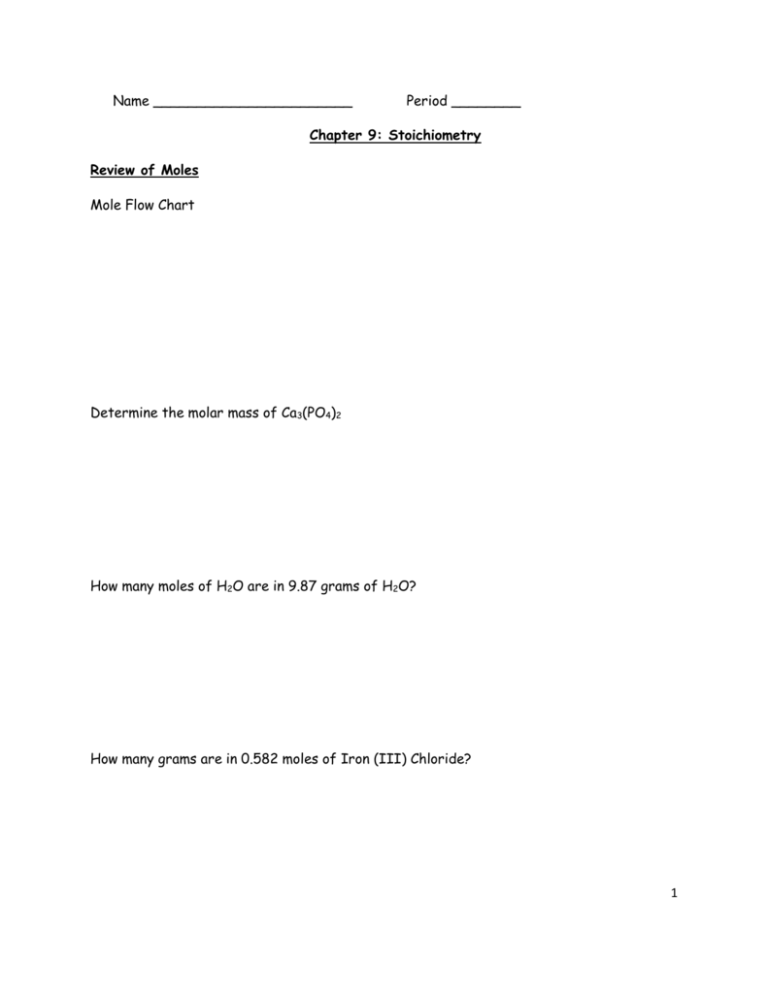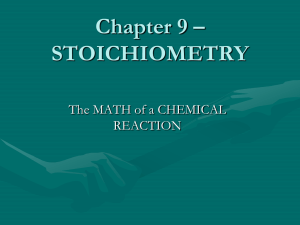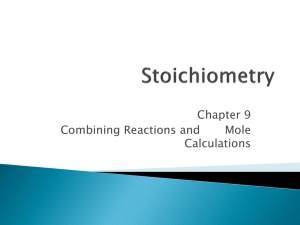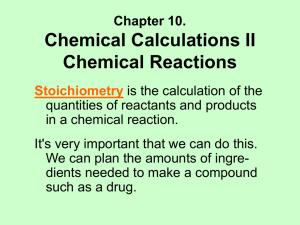Name Period ______ Chapter 9: Stoichiometry Review of Moles
advertisement

Name _______________________ Period ________ Chapter 9: Stoichiometry Review of Moles Mole Flow Chart Determine the molar mass of Ca3(PO4)2 How many moles of H2O are in 9.87 grams of H2O? How many grams are in 0.582 moles of Iron (III) Chloride? 1 __________________– calculation of quantities in chemical reactions. Calculations using balanced equations are called stoichiometric calculations. 1 N2 + 3 H2 → 2 NH3 One molecule of nitrogen reacts with 3 molecules of hydrogen to produce 2 molecules of ammonia, NH3. We could also say 1 mole of nitrogen reacts with 3 moles of hydrogen to product 2 moles of ammonia. OR 2 moles of nitrogen will react with 6 moles of hydrogen to produce 4 moles of ammonia. Keep in mind: 1. The ratio of moles in any chemical reaction will remain constant. a. Ex) 1 N2 + 3 H2 → 2 NH3 1:3:2 2. The mass of the reactants will equal the mass of the products 3. The number of atoms of each element in the reactant will equal the number of atoms of each element in the product 4. The number of moles in the reactant does NOT have to equal the number of moles in the product. 2 What have we learned so far? 1. Calculations using moles, formula units, ions, atoms, molecules, and grams. 2. Balance Chemical Reactions. 3. Predict products of chemical reactions. Mole-Mole Calculations 1 N2 + 3 H2 → 2 NH3 How many moles of nitrogen will react with 1.25 moles of hydrogen? Mole-Mole Calculations 1 N2 + 3 H2 → 2 NH3 How many moles of ammonia will be produced from the reaction of 2.35 moles of nitrogen with excess hydrogen? 3 Mole-Mole Calculations 1 N2 + 3 H2 → 2 NH3 How many moles of hydrogen does it take to produce 0.825 moles of ammonia? Calculations Steps 1. Determine the known and unknown. 2. Convert the known to moles 3. Use the balanced reaction to determine the relationship between known and unknown. Unknown is always numerator and known is denominator 4. Convert your unknown to the correct units based on what the problem is asking. 4 Moles to Mass Calculations 4 NH3 + 5 O2 → 4 NO + 6 H2O How many grams of water will be produced when 1.25 moles of NH3 reacts with excess O2? Moles to Mass Calculations 4 NH3 + 5 O2 → 4 NO + 6 H2O How many moles of O2 are needed to produce 32.6 grams of NO? 5 Moles to Mass Calculations 4 NH3 + 5 O2 → 4 NO + 6 H2O When 0.750 moles of NO are formed, how many grams of water would you also expect to be produced? Mass to Mass Calculations 4 NH3 + 5 O2 → 4 NO + 6 H2O How many grams of NH3 are required to produce 10.0 grams of water? 6 2 NaHCO3 → 1 Na2CO3 + 1 CO2 + 1 H2O How many grams of NaHCO3 are required to produce 0.507 moles of H2O? 2 NaHCO3 1 Na2CO3 + 1 CO2 + 1 H2O How many grams of NaHCO3 are required to produce 7.25 grams of H2O? 7 Say you want to make turkey sandwiches (each sandwich should have 1 slice of turkey and two slices of bread) and you have the following: 8 slices of bread 7 slices of turkey How many sandwiches can you make? Limiting Reagent: Excess Reactant: Limiting reagent or limiting reactant – substance in the reactants that limits how much of the product(s) can be made. 1. The reactants will combine until one of the reactants is used up. 2. The reaction will only continue if you add more of the reactant that was used up first. 3. A limiting reactant problem will be similar to a mass-mass calculation. 4. The difference is that you will be given amounts of two reactants. 5. Usually you will be asked to determine how much of a product can be produced. 6. If you do two mass-mass calculations you can determine which reactant is limiting and how much of the product is produced. 7. The reactant that produces the smallest amount of product is the limiting reactant. 8. The amount of product formed from the limiting reactant tells you the most product that can be made. 8 9. You can also find out how much of the excess reactant remains once the reaction stops. Excess reactant – substance that is left after the reaction has stopped. 1 N2 + 3 H2 2 NH3 How many grams of NH3 will be produced when 40.0 grams of N2 and 10.0 grams of H2 react? What is the limiting reactant? What is the excess reactant? 9 3Ba(OH)2 + 2Cr(NO3)3 2Cr(OH)3+ 3Ba(NO3)2 When 75 g Ba(OH)2 reacts 25 g Cr(NO3)3 how many grams of Ba(NO3)2 could be produced? What is the limiting reactant? What is the excess reactant? 10 Calculating Percent Yield 1. When doing any experiment it is easy for something wrong to happen. 2. It is unlikely for anyone to do an experiment where there are no errors. 3. When you go through a mass-mass (or grams to grams) calculation the value you determine is the theoretical yield. 4. Theoretical Yield – maximum amount of product that could be formed from the amounts of reactants given in the problem. 5. Actual Yield – amount that actually forms as a result of conducting a laboratory experiment. 6. Percent Yield – ratio of the actual yield to the theoretical yield times 100. 7. Percent Yield = Actual Yield x 100 Theoretical Yield Reasons not to get 100% Yield 1. Reactions do not always go to completion 2. Impure reactants 3. Side reactions or competing reactions 4. Loss of product during filtration or in transferring between different containers. 5. Not heated long enough to remove all water. 11 2 Al + 3 CuSO4 1 Al2(SO4)3 + 3 Cu What is the percent yield of copper if 4.65 g of copper is actually produced when 1.87 g of aluminum reacts with an excess of copper (II) sulfate? 12 2 Al + 3 CuSO4 1 Al2(SO4)3 + 3 Cu What is the percent yield if 20.0 grams of copper (II) sulfate produces an actual yield of 12.5 grams yield of aluminum sulfate? 13









